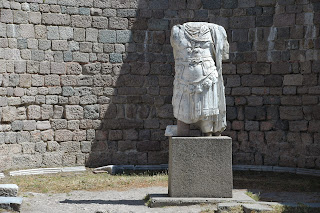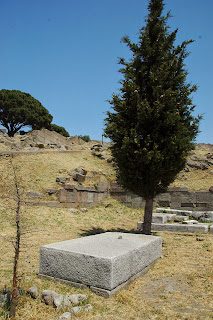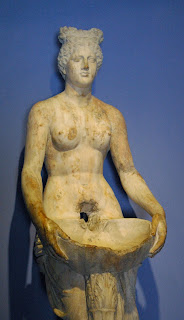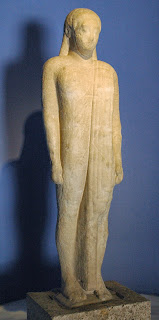Today our aim was to explore more of Pergamon. Yesterday was hot — 34C — and today promised to be more of the same. So today, up to the Acropolis.
We took the bus to the base of the hill — an adventure in itself, as the bus driver insinuated his vehicle through the chaotic Turkish traffic, with cars double parked in streets little wider than laneways. But we made it to the cable car.
The Acropolis is amazing. It was modelled on the Acropolis in Athens and was the residence of the 'upper crust' of Pergamon's society, so here you find the remains of the palaces of Eumenes II, king of Pergamon from 197-159 BC, and of Attalos I, king from 241-197 BC.
Probably the two most impressive constructs on the Acropolis are the Temple of Traianus (the Traianeum) and the Theatre, both of which can be clearly see from the Asklepieion. Within the Traianeum is the torso of a statue of the Emperor Trajan, very much where it would have stood nearly 2 millennia ago. This is a copy — most of the statues and artifacts have been removed from the site for preservation and display — but not far — just down into the Pergamon Museum, which we were to visit later on in the day. The one exception to this is the Great Altar to Zeus, the most magnificent construct on the Acropolis, which Carl Humann, the original excavator, effectively smuggled out of Turkey, and which now resides in the Pergamon Museum in Berlin — we will have to visit this when we get to Berlin!
After walking the site, rather hot and dehydrated, we dropped in to a little cafe, where Warren had a most welcome freshly-squeezed orange juice, and Suzie had a coffee. As a side note, the Turks seem to spend a lot of time drinking tea. Turkish coffee, although thick in texture, is rather low in caffeine. People here tend to get their caffeine fix from tea (çay), drunk black, usually sweetened with sugar, in clear glasses to allow the colour of the tea to be seen and the heat of the liquid to warm the hands — but whether they drink tea or coffee, it's an opportunity for conversation. There's an old story here about a lion that escaped from the zoo and took up residence in a government building. Nothing much happened while he took the occasional functionary or government minister, but when he took the man who brought around the tea, the posse was hot on the lion's heels!
We had decided to walk down the hill and into the town. We were wilting from the heat about half-way down, and when a Turkish couple pulled up and offered us a lift to the bottom, we gladly accepted. We asked them to drop us at the Red Basilica, another ancient site here.
The Red Basilica was originally a temple to the Egyptian god Serapis, but later served as a Byzantine Christian basilica, the St. Ioannes Church. This building, of which you now only see the red brick skeleton, covered an area of 260×100m. Originally the upper walls were faced with marble while the lower parts were surrounded by marble columns. The paving was also entirely marble. We weren't able to enter the courtyard itself, or even approach it closely, as there is huge restoration work going on, taking it back to the Egyptian temple form. One of the columns, in the shape of the lion-headed god of war, Maahes, has been reconstructed anew, and stands proudly outside the middle of the southern wall. The entrance to the temple faced west, which symbolizes the World of Death (or the Afterlife), crucial to the Egyptian religion.
We left the temple and walked a short way until we found a kebab shop. We had a fine lunch of Iskender Kebap, thin slices of beef laid over bread pieces, covered with a tomato sauce, with tomato, roast green pepper and yoghurt on the side. Wonderful. And washed down with çay or kahve.
After lunch, we wandered into the town, going into the old town with its covered bazaars and maze of narrow, cobblestone streets lined with shops. You could spend ages just enjoying this place!
Then past the police station, today draped with a huge flag — today is a public holiday, Youth Day, and the day they commemorate Kemal Atatürk — his actual birth date is unknown, but he himself said that he considered this day, the day on which he began 'national struggle' in 1919, to be his birthday. And so it is! The whole town is festooned with flags.
Passed a shoe-shine man, with his client sitting beside him with sandalled feet, waiting for his shoes to be returned to him!
And on to the Bergama Museum. This is devoted to finds from the Pergamon area, particularly from the Acropolis and the Asklepieion, but also from a rescue dig carried out before the filling of the Yortanlı Dam outside the town, just below the Acropolis. Here we saw the original of the torso of Trajan we met up on the Acropolis, and a head of Alexander the Great (admittedly, a reproduction — the original is in Istanbul), a statue of a Nymph that was obviously part of a fountain, and a beautiful mosaic floor depicting a Medusa. Had a good close-up look at an Ionic capital. You so often see them depicted from directly in front, that you tend to forget that the sides of the 'coils' were inevitably decorated, usually with leaves, and most often the same acanthus leaves that so characterize Corinthian columns.
We walked the way back to the campsite — an hour's walk, but the day was cooling down — passing shops and mosques on the way.
Tonight in the campsite we met up with a Canadian family, the parents giving their two young daughters a wonderful education. We spent some time swapping experiences. Part of the joy of travelling just has to be the people you meet along the way!
Distance driven — today, nil; to date, 20,463 miles ( 32,932 km )







































Yes,I'd agree they are as lucky to meet you two as you them. Have had four two hour workshops in the past two days and have another tomorrow afternoon. So might get some other necessary work done between now and then. All these monuments and statues. One forgets how often the Turks were overrun and ruled by foreigners. Their infrastructure was vast wasn't it? Kemal Attaturk was a great statesman I gather. They sure drape the flags on his day. That medusa mosaic was well done although I would never have given her a fat cherubic face. Gertie seems to rest in nice spots, trees and grass and wildfflowers. keep happy, cathy
ReplyDelete